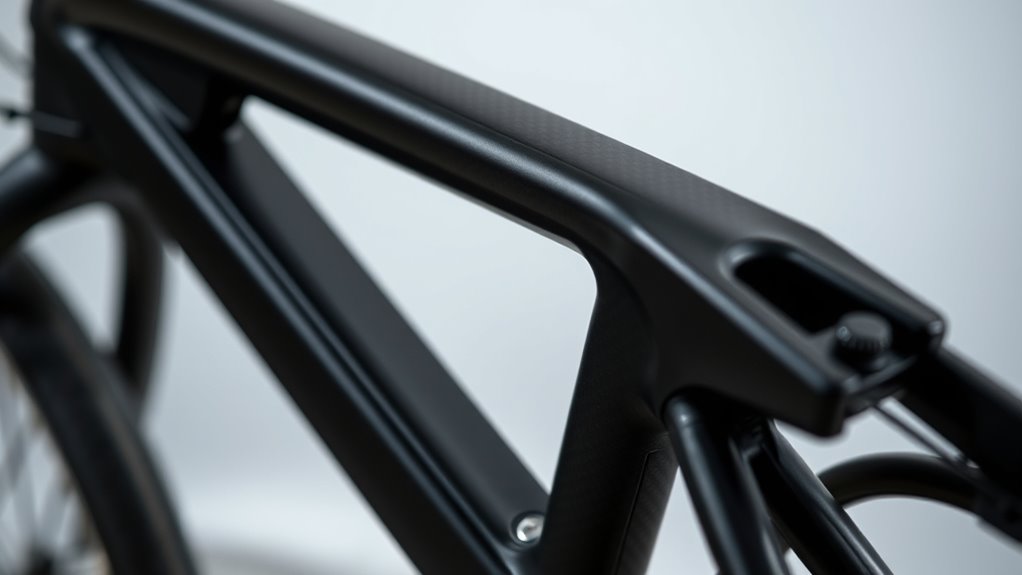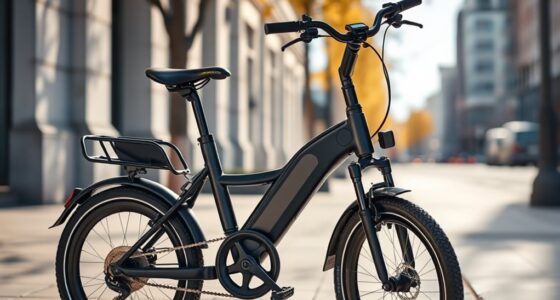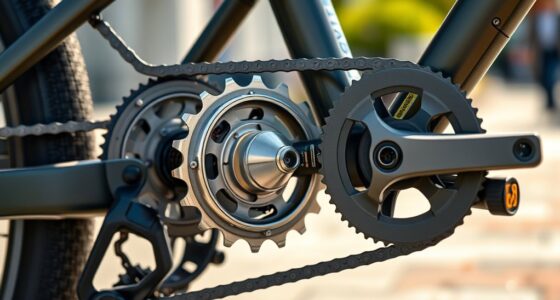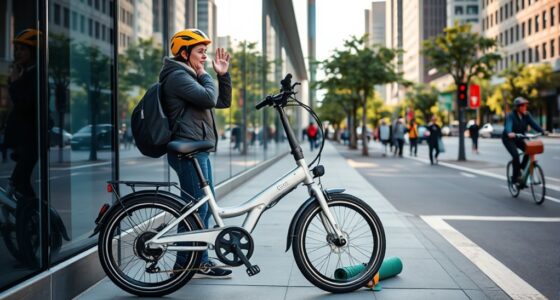Understanding the physics of folding frames involves how material choices and hinge designs influence stiffness, flex, and ride feel. When you choose materials like aluminum or carbon fiber, they affect how rigid or flexible the frame is, impacting responsiveness and comfort. Hinge design also plays a key role, providing stability during riding and smooth folding. By balancing these elements, you can optimize your bike’s performance and feel. Continue exploring to discover how these factors work together for the perfect ride.
Key Takeaways
- Frame material determines stiffness and flexibility, directly impacting ride responsiveness and shock absorption.
- High-quality hinges ensure smooth folding while maintaining structural integrity under pressure.
- The interplay between material stiffness and hinge design influences overall frame stability and resistance to flex.
- Increased stiffness enhances power transfer and responsiveness, while more flex offers comfort and shock absorption.
- Balancing material properties and hinge mechanics results in an optimal ride feel, combining stability with flexibility.

Have you ever wondered how folding frames effortlessly lock into place and withstand pressure? It all comes down to the clever combination of frame material and hinge mechanisms. The frame material is the backbone of the entire structure; it determines how stiff or flexible the frame can be. Materials like aluminum, carbon fiber, or high-strength steel are common choices because they balance weight and durability. Aluminum, for example, offers excellent stiffness while remaining lightweight, allowing the frame to resist bending under pressure. Carbon fiber provides even higher stiffness-to-weight ratios, giving you a rigid yet lightweight ride. High-strength steel, on the other hand, offers exceptional durability and resistance to deformation, which is especially beneficial in harsh conditions.
Frame materials like aluminum, carbon fiber, and high-strength steel balance weight, durability, and stiffness for optimal folding bike performance.
But the real magic happens at the hinge mechanisms. These tiny yet essential components are what allow the frame to fold smoothly while maintaining strength when locked in position. Hinge mechanisms are engineered to handle significant loads without slipping or loosening over time. They often incorporate precision-machined parts and robust locking systems, such as cam or latch mechanisms, which ensure the frame stays securely in place during use. When you fold or unfold the frame, the hinge mechanisms activate seamlessly, providing a tactile feel that confirms the frame’s locked position. This interplay between hinge design and frame material is key; a high-quality hinge paired with a stiff, durable material ensures the frame resists flex and maintains its integrity under pressure. Additionally, understanding the stiffness and flex of the frame helps riders optimize their riding experience by balancing responsiveness and comfort.
The stiffness of the frame affects how it responds to your input. A stiffer frame transmits power more efficiently to the wheels, giving you a more direct and responsive ride. Conversely, a more flexible frame can absorb shocks and vibrations, offering a smoother experience on rough terrain. The hinge mechanisms also contribute to this dynamic by ensuring the frame remains stable and secure, preventing unwanted movement or flex at critical joints.
In essence, the physics behind folding frames involves a delicate balance. The right frame material provides the necessary stiffness and durability, while the hinge mechanisms facilitate easy folding and reliable locking. When these elements work in harmony, you get a frame that’s not only easy to fold but also tough enough to handle pressure and maintain its ride feel. Understanding this balance helps you appreciate the engineering that makes modern folding bikes practical, resilient, and responsive. The next time you fold or unfold your bike, remember that it’s a finely tuned synergy of material science and mechanical design working behind the scenes.
Frequently Asked Questions
How Does Frame Material Affect Stiffness and Ride Feel?
Your frame material directly influences stiffness and ride feel through its material properties. For example, aluminum offers a responsive, stiff ride, giving you quick handling, while steel provides more flex, absorbing shocks for a smoother experience. Your rider preferences matter—if you want agility, go for stiffer materials; if comfort is your priority, choose more flexible options. Understanding these properties helps you select a frame that matches your riding style.
Can Frame Design Influence Vibration Absorption?
Your frame design can substantially influence vibration absorption, making your ride smoother than flying on a cloud. By optimizing frame resonance and incorporating effective damping mechanisms, you reduce unwanted vibrations that can jostle you. Thoughtful design choices, like tube shapes and material placement, help dissipate energy efficiently, ensuring you experience a more comfortable, controlled ride. This engineering magic transforms rough terrain into a gentle glide.
What Role Does Geometry Play in Frame Flex?
Frame geometry directly influences how much your bike flexes during rides. A tighter bend radius in the tubing typically reduces flex, making the frame stiffer, while a more relaxed bend allows more give, increasing flexibility. Your chosen geometry determines how forces are distributed across the frame, affecting ride comfort and handling. So, understanding the bend radius and geometry helps you tailor your bike’s flex to match your riding style.
How Do Different Riding Styles Impact Frame Stiffness Needs?
You’ll find that your riding style shapes what frame stiffness you need. If you’re aggressive and push your limits, a stiffer frame provides the control you crave, especially when maintaining chain tension and tire pressure over rough terrain. Conversely, a more relaxed rider benefits from a flexible frame that absorbs shocks. Think of your bike as an extension of yourself—matching its stiffness to your style keeps your ride smooth and responsive.
Are There Trade-Offs Between Stiffness and Durability?
Yes, there are trade-offs between stiffness and durability. When you choose a stiffer frame, it often handles load distribution better, offering a responsive ride. However, increased stiffness can lead to material fatigue over time, reducing durability. Conversely, more flexible frames absorb stress more evenly, extending lifespan, but may compromise performance. You need to balance your riding style and priorities to find the right stiffness-durability balance.
Conclusion
So, next time you marvel at a folding bike’s clever design, just remember—it’s all about physics. You thought flexibility meant weakness? Think again. Stiffness keeps you stable, yet too much ruins the ride. It’s a delicate dance of flex and firmness, all working behind the scenes. Ironically, the perfect ride depends on balancing these forces—proof that even in folding frames, physics rules. Who knew that tiny hinges could wield such power?









